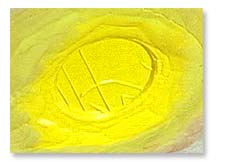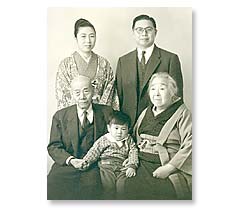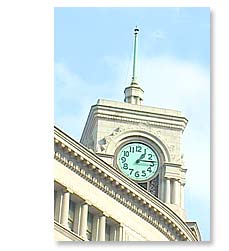 |
|
 |
�@Ginza�fs Namiki Dori Street, with many foreign brand-name stores,high-end restaurants, and art galleries, is known as a street of art and beauty. S. Watanabe Color Print Company, an old-standing woodcut print store on Namiki-dori Street, was founded in 1906.The store collects Ukiyo-e and Shin-Hanga, both traditional and new print art, and attracts many visitors from all over the world.Our interview for the month was with Maestro. Shoichiro Watanabe, the 3rd owner of the store. |
 |
 |

|
| What is a Woodcut? |
 |
 |
|
�@Ukiyo-e printsby Hokusai Katsushika, Hiroshige Utagawa, and so on, who flourished in the Edo era, were completed by engraving on a wood block and then adding colors repeatedly.After the Meiji era, a number of famous artists such as Hasui Kawase and Shiko Munakata introduced their works in and outside of Japan, and it was very popular overseas.
�@ |
|
|
 |
| Before I became the 3rd owner |
 |
�@The store was first established in 1906 in Kyobashi by my grandfather Shozaburo Watanabe.In the Taisho era (1912-1925), my grandfather started and completed an original new print art genre with great contemporary artists at the time. It was called Shin-hanga, based on the Ukiyo-e method. Shinsui Ito, for a beautiful woman, or Hasui Kawase, for landscapes, represents this style, which pursues more artistic quality. With this history, our store is known for Shin-hanga, as well as for original Ukiyo-e prints, as well as works by contemporary artists. My father produced woodprints as the 2nd owner, and then I became the 3rd.
|
| As an Original Woodprint Publisher |
 |
�@
I was born and raised in Ginza as a only child, so I knew I would one day take over the store. Since I was raised surrounded by high quality things, my ability to judge works of good quality grew naturally. Raised in such an environment, I worked at one of the department stores in Ginza after graduating from university, and then took over this store. Currently I produce works by contemporary artists, introduce them overseas, and I am on a popular TV program, �gNandemo Kantei-dan,�h as a commentator. When I find a rare piece and hand it to my customer, that is the greatest moment of the business.
|
|
 |
 |
| Long years of experience |
 |
�@First, a specialist, called �gHori-shi,�h engraves a woodblock, using the guidelines drawn by an artist. The number of woodblocks that are engraved is the same for how many colors are present. Then a printer, called �gSuri-shi,�h adds colors one by one manually after preparing them. He places Japanese paper over the wood block that has pigment on it, and rubs it with a tool, called a baren. He repeats this process for each color, from light to dark ones. It is difficult to keep the coloring balanced as a whole when colors are added one by one, though this process creates a profound woodblock print. After all the colors are rubbed on the paper, a woodprint is completed.At our store, we have 2 Suri-shi to do colors manually. Here, let me introduce one of them, Mr. Eiji Watanabe.
|
|
|
 |
| The community and the future |
 |
�@As you know, Namiki-dori Street is a very crowded street with many foreign brand stores that attract a lot of people.Those who run businesses here make great efforts behind the scenes to stimulate our customers, as always. We are very proud in being one of the traditional stores, as well as being the one who created Shin-hanga, the new genre of woodblock prints for the world. In 2006, we are having our 100th anniversary, and our 50th anniversary of the death of Hasui Kawase in 2007. We are planning a number of special events in the coming years. We will do our best to ensure that woodblock prints are loved more by the people. For example, when I found a rare piece and handed it to my customer, he said, �gI�fve been waiting for this for a long time.It�fs been 20 years since I started searching for this piece of work.Finally, I have gotten it.Thank you so much.�hRegardless of my profit, I was very happy, too.
|
|
 |
|
 |
 |
 |
 |
| |
 |
|
 |
S. Watanabe Wood Cut Print
Original Ukiyo-e (from a few thousand yen), Ukiyo-e Replica (8,000 yen to 10,000 yen), Hasui Kawase Shin-hanga (21,000 yen), Contemporary work (2,000 yen), Mototsugu Sugiyama (30,000 yen) and more.
Greeting cards (525 yen), contemporary calendars, and art books are recommended as a gift.
Free Ukiyo-e authentification, or small purchases are available. |
 |
 Add: 8-6-19 Ginza, Chuo-ku Add: 8-6-19 Ginza, Chuo-ku
Phone�F03-3571-4684
FAX�F03-3572-8887
URL�Fhttp://www.hangasw.com
Office Hours�FMon-Sat�F9:30�`20:00, Holidays�F9:30�`17:00, CLosed on Sunday
Ginza station (Ginza line, Marunouchi line), Shimbashi station |
|
|
 |
 |
 |
|
 |
|
 |